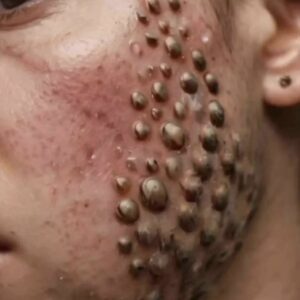Can You Spot All 8 Faces? The Optical Illusion That’s Testing the Internet’s IQ
Optical illusions have a way of making us question what we see and how our brains process visual information. The image above has recently gone viral, challenging viewers with a bold claim: “Only people with an IQ of 140 can spot all eight faces.” It’s a playful test of observation and attention to detail that’s both entertaining and puzzling. Let’s dive deeper into what makes this illusion so fascinating and why it’s captured so many people’s curiosity.
The Visual Puzzle: More Than Meets the Eye
At first glance, this quirky illustration might seem simple — a cartoon-style woman sitting thoughtfully on a toilet. But look closer, and you’ll notice something strange. The bathroom fixtures, walls, and even the artwork contain cleverly hidden human faces.
The challenge is to find all eight of them — a task that sounds easy until you actually start searching. Each face is blended seamlessly into the design, forcing your brain to switch between literal interpretation (seeing objects) and abstract recognition (seeing faces).
This dual interpretation is what makes optical illusions like this so engaging — and so tricky.
Why Our Brains Love Optical Illusions
Our brains are wired to recognize faces almost instantly — it’s one of the first visual skills humans develop. This phenomenon is called pareidolia, the tendency to perceive familiar shapes, particularly faces, in unrelated objects. That’s why you might see a “face” in clouds, tree bark, or even on the surface of the moon.
In this illusion, the artist uses that same instinct against you. By embedding facial features into toilets, tiles, and artwork, the image tricks your perception. Your eyes may scan the scene a dozen times before your brain catches up and finally identifies the hidden expressions.
What’s fascinating is how differently people react to this challenge. Some spot all eight faces immediately, while others struggle to see more than three or four. This variation has nothing to do with intelligence — it’s about visual focus, pattern recognition, and how your brain processes ambiguity.
The Hidden Faces: A Breakdown of the Challenge
Let’s take a closer look at where the faces hide in the image — without giving away too much of the fun.
The first face is obvious — the woman’s face herself, front and center.
The second and third faces appear in the toilet fixtures. Each bowl has a serene, sculpted face integrated into its design.
The fourth face can be found in the wall art behind her — a large, abstract expression looking directly at you.
The fifth and sixth faces emerge in unexpected places, subtly formed in the floor tiles and the wood paneling.
The seventh and eighth faces may take more patience to find, hiding where you’d least expect — proving that persistence pays off in puzzles like this.
Each time you spot a new one, your brain experiences a small surge of dopamine — the chemical associated with satisfaction and reward. That’s why people find optical illusions addictive. They’re not just visual tricks; they’re mental games that make your brain feel good when it solves the puzzle.
What Makes This Illusion Go Viral
Images like this explode online because they combine entertainment, competition, and curiosity. The phrase “Only people with an IQ of 140 can…” instantly grabs attention. It challenges you directly, making you want to prove yourself — even if you know it’s just for fun.
Social media thrives on interaction, and this kind of illusion invites viewers to comment, argue, and compare results. Some people proudly declare they’ve spotted all eight faces, while others beg for hints. It’s an interactive experience that bridges art, psychology, and community engagement.
But beyond the playful ego boost, there’s something deeper going on. Illusions remind us that our brains aren’t perfect recorders of reality. They interpret, guess, and fill in gaps — meaning what you “see” isn’t always the full picture.
The Psychology Behind Seeing (or Missing) the Faces
Why can some people spot hidden images instantly while others struggle? It comes down to how we process visual information. There are two main cognitive pathways at play:
Top-down processing: Your brain uses context, memory, and expectations to interpret what it sees.
Bottom-up processing: Your eyes take in raw sensory data — shapes, colors, edges — and build meaning from scratch.
In this illusion, your brain constantly switches between these two modes. At first, you recognize the overall scene (a woman in a bathroom), but as you look longer, your perception shifts and you begin to notice faces emerging from unexpected places.
If you’re naturally detail-oriented, you might spot the hidden features faster. If you focus on the “big picture,” it could take longer for your mind to notice the subtleties.
The fun part? Once you see a hidden face, you can’t unsee it. Your brain locks it into memory, forever changing how you view the image.
Optical Illusions and Intelligence: Is There a Real Connection?
Despite what the meme claims, spotting all eight faces doesn’t actually prove you have an IQ of 140. But it does show that you have sharp visual awareness and strong cognitive flexibility — the ability to shift perspectives quickly.
Studies show that people who enjoy puzzles, illusions, and visual challenges often demonstrate higher levels of creative problem-solving. They’re curious thinkers who like exploring multiple possibilities instead of settling for the obvious.
So while this illusion won’t earn you a genius badge, it does engage the same mental muscles that creative and analytical minds use every day.
The Artistic Side of Illusion
Beyond the psychology, there’s pure artistry in creating illusions like this. The artist must balance clarity and ambiguity perfectly — making the faces visible enough to find, but not so obvious that they jump out immediately.
In this case, the use of familiar cartoon elements adds a playful twist. The bathroom setting, whimsical character, and surreal design all blend humor with mystery. It’s modern pop art meets mind puzzle — a visual riddle wrapped in everyday imagery.
That’s what makes this illustration so appealing: it’s not just about spotting faces; it’s about appreciating how creativity and perception intertwine.
Conclusion: The Fun of Seeing What Others Miss
This Eight Faces Optical Illusion is more than a social media challenge — it’s a reminder of how fascinating the human brain truly is. What begins as a funny cartoon transforms into a test of focus, observation, and imagination.
Whether you spot all eight faces or just a few, the real reward lies in the process — that moment when your perception shifts and something new comes into view. It’s proof that sometimes, the world hides its wonders in plain sight, just waiting for you to look a little closer.
So, are you ready to test your eyes again? Take one more look. You might just spot that last hidden face staring right back at you.





